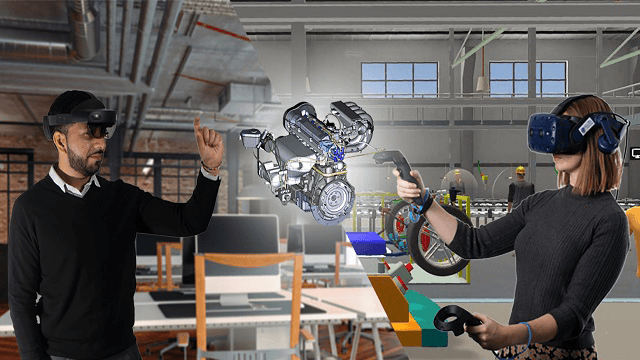A new Theorem-AR app and a new supported device are included in the Theorem-XR Q3 2021 release.
The Q3 2021 Theorem-XR release is now available and is packed with innovative new features and enhancements that are offering users the opportunity to extend their capabilities when it comes to optimizing, visualizing and collaborating with their engineering and design data in XR.
What’s included in this latest release? The big news is that Theorem-AR is back! And the release also includes a newly supported device, additional support for Microsoft ARR (Azure Remote Rendering), and general updates for a number of our Theorem-XR experiences in the HoloLens 2, and the Visualization Pipeline.
In more detail…
Theorem-AR
Our Augmented Reality app has been updated and is now available on iOS, Android and Windows.
Based on our Visualization Experience, Theorem-AR focuses on 4 main modes:
- Image tracking – Track 3D digital content against a chosen image target
- Model Tracking (target model) – search for and track 3D digital content against physical objects
- Model Tracking (alternate model) – search for and track 3D digital content against physical objects but display further 3D digital content once detected.
- The AR Viewer (not available in Windows) means that you can use your environment and place 3D digital content on recognised surfaces. The viewer also offers the ability to scan surfaces and drop models on to them.
You can then snapshot the images generated, mark them up and save them to the device.
ARR in HoloLens 2
Besides general additional support for remote rendering, for HoloLens 2 users this release now offers users a full Factory Layout capability in ARR, with the ability for rendering, and interacting with, huge quantities of data. Additionally, data that is rendered in the cloud by Microsoft can now be picked up and interacted with, receiving live feedback from the server.
Learn more about Theorem and Microsoft ARR
HoloLens 2 Support
The Q3 2021 release includes general updates for the range of Theorem-XR use case based experiences including Design Review, Factory Layout, Guides and Visualization in the HoloLens 2.
Support for HTC VIVE Focus 3
We have added another device to the growing list of Augmented, Mixed and Virtual Reality devices that we support. The VIVE Focus 3 takes advantage of VIVE Business streaming by using wifi to render data and then stream it from your laptop straight to the headset.
See all supported Virtual Reality devices
Theorem-XR
Theorem-XR enables you to visualize your 3D CAD and PLM assets in context and at full scale, using Augmented, Mixed and Virtual Reality technologies on the device of your choice. Theorem-XR is data and device neutral, and offers a range of use case based experiences, so offers something for everyone at all stages of their XR journey.
Theorem-XR’s ‘standard’ engineering-based use case experiences work collaboratively, enabling remote teams and home-based staff to join and work in an immersive multi-user environment, from anywhere where there’s an internet connection. Even desktop users can join a collaborative session.
For many, getting 3D data into XR is the biggest stumbling block on the road to adoption. With Theorem-XR, the experiences are underpinned by the Visualization Pipeline which provides a fully automated process that takes 3D data assets directly into Theorem-XR, or for the creation of Unity or Unreal assets for use in internally developed XR solutions. By using the Visualization Pipeline to prepare and optimize CAD data, the difficulties that can be encountered when trying to get 3D data into XR are removed.
There are many benefits to bringing the latest XR technologies into existing workflows- reduce costs, improve product quality and support the faster development of products and manufacturing processes across the enterprise. By using Theorem-XR to undertake everyday engineering tasks, it allows you to visualize your 3D CAD data at full scale and in context (the way it should be!), rather than from the confines of a 2D computer screen, bridging the gap between the digital and the physical.
For more information visit our Extended Reality page.




